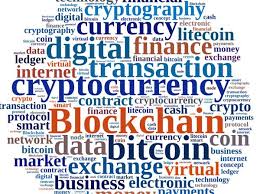Alongside artificial intelligence and robotics, Blockchain technology is enjoying widespread popularity around the globe. The surrounding hype seems to increase by the minute. Pundits and supporters see a plethora of applications for the technology not limited just to the financial sector. But to the average person, Blockchain technology is mystifying, given its technical complexity. If you do not know what a nonce is, you are not as cool as those who do.
 There are now plenty of books, papers and newspaper articles dealing with Blockchain. One of them, by Don Tapscott and his son, caught my attention. This book is a sound attempt to make a case for Blockchain as a disruptive technology that will impact most aspects of our lives – and not just financial services as first predicted. The book is also a call to political and economic leaders to join the “World Wide Ledger” revolution. In their view, Blockchain will be as disruptive as the Internet was 25 years ago, if not more. However, the authors are smart enough to discuss the risks and potential pitfalls of the technology. We get a final chapter that furnishes a “roster” of those who should lead the revolution. The authors deal with social agency, an issue lacking in most technology books.
There are now plenty of books, papers and newspaper articles dealing with Blockchain. One of them, by Don Tapscott and his son, caught my attention. This book is a sound attempt to make a case for Blockchain as a disruptive technology that will impact most aspects of our lives – and not just financial services as first predicted. The book is also a call to political and economic leaders to join the “World Wide Ledger” revolution. In their view, Blockchain will be as disruptive as the Internet was 25 years ago, if not more. However, the authors are smart enough to discuss the risks and potential pitfalls of the technology. We get a final chapter that furnishes a “roster” of those who should lead the revolution. The authors deal with social agency, an issue lacking in most technology books.
In their view, Blockchain is the Internet’s “trust protocol.” What does this mean? Satoshi Nakamoto, the still-anonymous creator of Bitcoin and Blockchain, established a set of rules embedded in software that safeguards the integrity of data exchanged over the networks without an internal or external need trusted third party. Instead, trust is distributed among the software users that runs Blockchain – licensed as open-source software and therefore available in principle to anyone who cares to download it.
What is Blockchain? The blockchain is a distributed database o ledger that records network transactions in blocks. Each block of transactions is interlinked and interdependent as, say, the last transaction block recorded on the ledger must have a link to the previous, which is linked to the one before, and so on and so forth. In this way, it is feasible to track any specific transaction to its very origin. Attempting to change or hack any block is practically impossible. In this way, “…The blockchain is a distributed ledger representing the network consensus on every transaction that has ever occurred.” (pg. 7)
Blockchain technology is 1. Distributed: Every user has a copy of the complete ledger on her/his computer (does not work on mobile phones, though!); 2. Public: In principle, anybody on the network has access and can check every single entry on the ledger. And 3. Encrypted: The distributed ledger demands encryption tools, particularly public and private key protocols, to do any transaction on the network.
On this basis, “This new digital ledger of economic transactions can be programmed to record virtually everything of value and importance to humankind: birth and death certificates, marriage licenses, deeds and titles of ownership, education degrees, financial accounts, medical procedures, insurance claims, votes, provenance of food, and anything else that can be expressed in code.” (pg. 7, the emphasis is mine)
Having defined and identified its potential, the Taspcostt’s go ahead and offer seven key “design principles“:
- Networked Integrity: Key here is that trust should be intrinsic to the network, not extrinsic. Blockchain offers this in good supply thanks to the ways it promotes consensus building. The primary tool to do this is the proof of work mechanism that requires that those who want to add a new block of transactions to the ledger compete among themselves and solve a complex puzzle that only has one solution, using the computing power they might have at their disposal. Once a solution is found, all other network users can corroborate it. The new block is added to the network. Other mechanisms include proof of stake, proof of activity, proof of capacity, and proof of storage.
- Distributed Power: As the technology is based on peer-to-peer networks, no single node has more control or power than any other, even if nodes are hacked or cut off the network. Our authors see this as an opportunity for the creation of new distributed models for wealth creation.
- Value as an Incentive: Blockchain offers incentives to all network participants. The best example here is Bitcoin that users can mine or use to buy products and services.
- Security: Blockchain is inherently secure, much more than any other Internet application or protocol.
- Privacy: Privacy features are also embedded in Blockchain technology. In principle, people should control their own data. The opposite is happening today, where surveillance is pervasive, and users have little to no control over their own information.
- Rights Preservation: In Blockchain, ownership rights are transparent and individual freedoms are respected. Smart contracts are one example here.
- Inclusion: “The foundation of prosperity is inclusion, and blockchains can help. Let’s be clear that inclusion has multiple dimensions. It means an end to social, economic and racial hegemony, and the end to discrimination based on health, gender, sexual identification, or sexual preference.” (pg. 51)
With this in hand, the authors examine the potential transformations that Blockchain could bring forward. Separate chapters are dedicated to Financial services; re-inventing the firm; new business models, the Internet of things; economic inclusion and prosperity; government and democracy; and cultural issues, including education, freedom of speech, music, and the arts.
Let us examine in more detail the chapters on economic inclusion and government are of most personal interest. The rationale for the latter is simple: Economic inclusion is the basis of prosperity without sharp inequality. They identify two drivers for economic inclusion: financial inclusion and new models for entrepreneurship. And the starting point for both is financial identity. Indeed, “This moving into a period of human history whereby vast numbers of people can become owners of wealth, through distributed ledger technology” (pg. 181). Also included under the prosperity header are “humanitarian aid” and asset ownership a la De Soto. There are three main obstacles: 1. The lack of universal access to technology; 2. Levels of literacy; and 3. Corruption.
For rebuilding government and democracy, the seven Blockchain design principles put forward by our authors become very handy. The first sector where Blockchain can make a significant impact is by helping improve government services and operations. A second-tier includes empowering people to do things on their own, self–service, to complement the first one. Third, improving democracy (defined as voting) by promoting Blockchain voting. Fourth, it is also possible to devise new models for politics and justice administration. Finally, engagement with citizens to tackle big problems is now much more feasible and effective.
What about the governance of blockchains? The book addresses this vital issue in its last pages and raises six related questions: 1. Design such a network; 2. Shall it be built from scratch or based on existing institutions that manage financial issues; 3. Mandate; 4. Its power to implement and enforce policy; 5. Representation and accountability issues; and 6. Relation to nation-states.
The experience of the development and evolution of Internet Governance becomes critical here and should serve as a basis to build similar Blockchain mechanisms. Based on this, the authors name nine types of networks( knowledge, delivery, policy, advocacy, watchdog, platforms, standards, institutions, and diasporas) that should be part and parcel of the overall governance network. Do not expect to find a lot of original thinking here. This tries to answer the who question in the process.
But how to make this happen in reality? “Lest we are accused of being technology determinists or techno-utopians, may we propose that it’s time for a new social contract for the digital age?” (increase. 308). This will require 1. A declaration of Interdependence (as we all have rights); 2. Agreement on principles (distribution of opportunity and prosperity as an entry point); 3. New laws to overcome current obstacles; 4. Institutional transformation; and 5. New physical infrastructures demanding new partnerships and understanding among stakeholders.
So, while in their view, Blockchain’s way forward is clear, it will not be easy to get there, if at all.
Developing and implementing new social contracts on a global scale is much more complicated than Blockchain itself.
Tapscott, Don & Alex Tapscott. 2016. Blockchain Revolution. How the Technology Behind Bitcoin is Changing Money, Business and the World. New York: Penguin Random House. ISBN: 978-1-101-980132.
Cheers, Raúl

